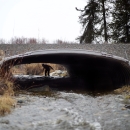States
MarylandThis project will remove eight barriers and open 30 miles of stream in Maryland’s North Branch Potomac River watershed. Two culvert replacements and a dam removal in Georges Creek will build on previous efforts in the watershed to provide a safe cold-water habitat and open new migratory pathways for brook trout, reduce flood risk, and improve the water supply. This project will also replace aging infrastructure while providing educational opportunities at partnering Frostburg State University. As climate change climate change
Climate change includes both global warming driven by human-induced emissions of greenhouse gases and the resulting large-scale shifts in weather patterns. Though there have been previous periods of climatic change, since the mid-20th century humans have had an unprecedented impact on Earth's climate system and caused change on a global scale.
Learn more about climate change increases temperatures and the magnitude of flood events, removing this high-hazard dam will increase public safety and prevent possible dam failure.
Project Quick Facts:
| Project Status | In Development |
| Location | MD, Garrett/Allegany County |
| NFPP Project Funding | $1,200,000 |
| Restoration Techniques | Dam Removal, Culvert Replacement |
| Accomplishments | 30 Stream Miles Reopened |
| Partner Project Lead | Maryland Department of Natural Resources |
The National Fish Passage Program combines technical expertise with a track record of success.
Implemented primarily through the Service's Fish and Wildlife Conservation Offices, the National Fish Passage Program provides financial and technical assistance to partners across the country. Since 1999, the program has worked with over 2,000 local communities, Tribes, and private landowners to remove or bypass over 3,400 barriers to fish passage fish passage
Fish passage is the ability of fish or other aquatic species to move freely throughout their life to find food, reproduce, and complete their natural migration cycles. Millions of barriers to fish passage across the country are fragmenting habitat and leading to species declines. The U.S. Fish and Wildlife Service's National Fish Passage Program is working to reconnect watersheds to benefit both wildlife and people.
Learn more about fish passage and reopen access to over 61,000 miles of upstream habitat for fish and other animals. Staff have expertise in fish migration and biology as well as financial, engineering, and planning assistance to communities, Tribes, and landowners to help them remove barriers and restore rivers for the benefit both fish and people.
Fish passage project proposals can be initiated by any individual, organization, government, or agency. However, proposals must be submitted and completed in cooperation with a Fish and Wildlife Conservation Office. (Please note that fish passage projects being used for federal or state compensatory mitigation or required by existing federal or state regulatory programs are not eligible for funding through the National Fish Passage Program.)
CONTACT A FISH PASSAGE COORDINATOR IN YOUR AREA TO GET STARTED.


